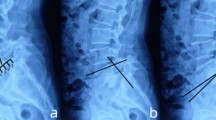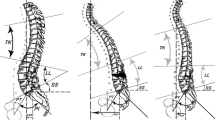Abstract
Background
Sagittal decompensation after pedicle subtraction osteotomy (PSO) is considered as late onset complication. Several mechanisms have been suggested, but little attention has been paid to the caudal end of lumbar instrumented fusion, especially sacral iliac joint (SIJ) deterioration.
Methods
Clinical histories and radiographic sagittal parameters of two patients with SIJ luxation after PSO are presented. The biomechanical failure mechanism and risk factors are analysed.
Results
Two patients underwent correction of fixed anterior sagittal imbalance by PSO, followed by pseudarthrosis revision surgery. Both of them sustained persistent sacroiliac pain, progressive recurrence of anterior imbalance and progressive pelvic incidence (PI) increase around 10°. An acute bilateral SIJ luxation occurred in both patients leading to sharp increase or PI around 20°. One patient was treated by SIJ fusion and the other patient was placed on non-weight-bearing crutch ambulation for 1 year. Both patients had a high preoperative PI (95° and 78°). A theoretical match between lumbar lordosis (LL) and PI was not achieved by PSO. Osteopenia was present in both patients. Computed tomography evidenced L5–S1 pseudarthrosis and sacroiliac joint violation by pelvic or sacral ala screws.
Conclusion
Patients with high PI might seek for further compensation at their SIJ when lacking LL after PSO. Chronic anterior imbalance might lead to progressive weakening of sacroiliac ligaments. Initial circumferential lumbosacral fusion and accurate iliac screw fixation might reduce stress on implants, risk for pseudarthrosis, implant failure and finally SIJ deterioration. Bone mineral density should further be investigated preoperatively.





















Similar content being viewed by others
References
Berjano P, Aebi M (2015) Pedicle subtraction osteotomies (PSO) in the lumbar spine for sagittal deformities. Eur Spine J 24(Suppl 1):S49–S57
Yang BP, Ondra SL, Chen LA, Jung HS, Koski TR, Salehi SA (2006) Clinical and radiographic outcomes of thoracic and lumbar pedicle subtraction osteotomy for fixed sagittal imbalance. J Neurosurg Spine 5(1):9–17
Lee SH, Kim KT, Suk KS, Lee JH, Seo EM, Huh DS (2011) Sagittal decompensation after corrective osteotomy for lumbar degenerative kyphosis: classification and risk factors. Spine (Phila Pa 1976) 36(8):E538–E544
Schwab FJ, Patel A, Shaffrey CI, Smith JS, Farcy JP, Boachie-Adjei O, Hostin RA, Hart RA, Akbarnia BA, Burton DC, Bess S, Lafage V (2012) Sagittal realignment failures following pedicle subtraction osteotomy surgery: are we doing enough? Clinical article. J Neurosurg Spine 16(6):539–546
Cho KJ, Kim KT, Kim WJ, Lee SH, Jung JH, Kim YT, Park HB (2013) Pedicle subtraction osteotomy in elderly patients with degenerative sagittal imbalance. Spine (Phila Pa 1976) 38(24):E1561–E1566
Legaye J, Duval-Beaupere G, Hecquet J, Marty C (1998) Pelvic incidence: a fundamental pelvic parameter for three-dimensional regulation of spinal sagittal curves. Eur Spine J 7(2):99–103
Mac-Thiong JM, Roussouly P, Berthonnaud E, Guigui P (2011) Age- and sex-related variations in sagittal sacropelvic morphology and balance in asymptomatic adults. Eur Spine J 20(Suppl 5):572–577
Ha KY, Lee JS, Kim KW (2008) Degeneration of sacroiliac joint after instrumented lumbar or lumbosacral fusion: a prospective cohort study over five-year follow-up. Spine (Phila Pa 1976) 33(11):1192–1198
Katz V, Schofferman J, Reynolds J (2003) The sacroiliac joint: a potential cause of pain after lumbar fusion to the sacrum. J Spinal Disord Tech 16(1):96–99
Wood KB, Geissele AE, Ogilvie JW (1996) Pelvic fractures after long lumbosacral spine fusions. Spine (Phila Pa 1976) 21(11):1357–1362
Mathews V, McCance SE, O’Leary PF (2001) Early fracture of the sacrum or pelvis: an unusual complication after multilevel instrumented lumbosacral fusion. Spine (Phila Pa 1976) 26(24):E571–E575
Khan MH, Smith PN, Kang JD (2005) Sacral insufficiency fractures following multilevel instrumented spinal fusion: case report. Spine (Phila Pa 1976) 30(16):E484–E488
Papadopoulos EC, Cammisa FP Jr, Girardi FP (2008) Sacral fractures complicating thoracolumbar fusion to the sacrum. Spine (Phila Pa 1976) 33(19):E699–E707
Vavken P, Krepler P (2008) Sacral fractures after multi-segmental lumbosacral fusion: a series of four cases and systematic review of literature. Eur Spine J 17(Suppl 2):S285–S290
Wilde GE, Miller TT, Schneider R, Girardi FP (2011) Sacral fractures after lumbosacral fusion: a characteristic fracture pattern. AJR Am J Roentgenol 197(1):184–188
Cho KJ, Suk SI, Park SR, Kim JH, Kang SB, Kim HS, Oh SJ (2010) Risk factors of sagittal decompensation after long posterior instrumentation and fusion for degenerative lumbar scoliosis. Spine (Phila Pa 1976) 35(17):1595–1601
Legaye J (2014) Influence of age and sagittal balance of the spine on the value of the pelvic incidence. Eur Spine J 23(7):1394–1399
Mao N, Shi J, He D, Xie Y, Bai Y, Wei X, Shi Z, Li M (2014) Effect of lordosis angle change after lumbar/lumbosacral fusion on sacrum angular displacement: a finite element study. Eur Spine J 23(11):2369–2374
Kelly MP, Lenke LG, Bridwell KH, Agarwal R, Godzik J, Koester L (2013) Fate of the adult revision spinal deformity patient. A single institution experience. Spine (Phila Pa 1976) 38(19):E1196–E1200
Zhu F, Bao H, Liu Z, Bentley M, Zhu Z, Ding Y, Qiu Y (2014) Unanticipated revision surgery in adult spinal deformity. An experience with 815 cases at one institution. Spine (Phila Pa 1976) 39(26B):B36–B44
Finger T, Bayerl S, Onken J, Czabanka M, Woitzik J, Vajkoczy P (2014) Sacropelvic fixation versus fusion to the sacrum for spondylodesis in multilevel degenerative spine disease. Eur Spine J 23(5):1013–1020
Shen FH, Mason JR, Shimer AL, Arlet V (2013) Pelvic fixation for adult scoliosis. Eur Spine J 22(Suppl 2):S265–S275
Frymoyer JW, Howe J, Kuhlmann D (1978) The long-term effects of spinal fusion on the sacroiliac joints and ilium. Clin Orthop Relat Res 134(7):196–201
Ohtori S, Inoue G, Orita S, Yamauchi K, Eguchi Y, Ochiai N, Kishida S, Kuniyoshi K, Aoki Y, Nakamura J, Ishikawa T, Miyagi M, Kamoda H, Suzuki M, Kubota G, Sakuma Y, Oikawa Y, Inage K, Sainoh T, Takaso M, Toyone T, Takahashi K (2013) Comparison of teriparatide and bisphosphonate treatment to reduce pedicle screw loosening after lumbar spinal fusion surgery in postmenopausal women with osteoporosis from a bone quality perspective. Spine (Phila Pa 1976) 38(8):E487–E492
Author information
Authors and Affiliations
Corresponding author
Ethics declarations
None of the authors has any potential conflict of interest.
Rights and permissions
About this article
Cite this article
Charles, Y.P., Yu, B. & Steib, JP. Sacroiliac joint luxation after pedicle subtraction osteotomy: report of two cases and analysis of failure mechanism. Eur Spine J 25 (Suppl 1), 63–74 (2016). https://doi.org/10.1007/s00586-015-4094-8
Received:
Revised:
Accepted:
Published:
Issue Date:
DOI: https://doi.org/10.1007/s00586-015-4094-8




